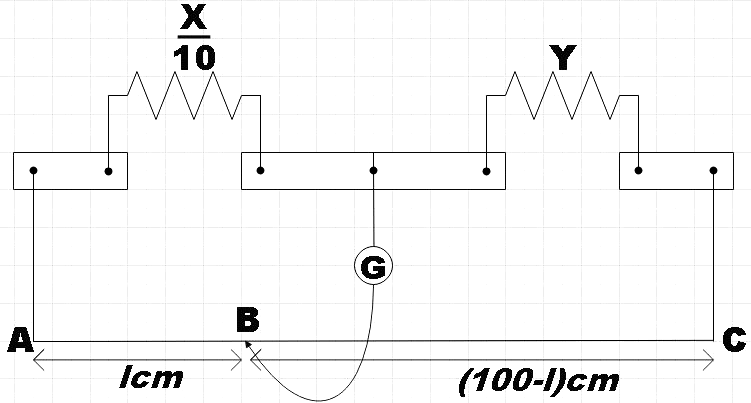
An unknown resistance is put in one gap and a resistance of $60\Omega $ in the other gap of a meter bridge and null point is obtained. If unknown resistance is now shunted by a resistance $\dfrac{1}{9}$ of its value, calculate the known resistance which will give the same null point as before.
Answer
559.2k+ views
Hint: As a first step, you could recall the expression for balanced condition of a meter bridge. Now you could substitute accordingly as per initial conditions given in the question in that expression. Then you could do the same for the second part where the unknown resistance is shunted. Combining both, you will get the value of the resistance at the right gap in the second part.
Formula used: Balanced condition of the meter bridge,
$\dfrac{l}{\left( 100-l \right)}=\dfrac{P}{Q}$
Complete step by step answer:
In the question, we are given a meter bridge. In the left gap of the bridge, an unknown resistance is put and in the other gap we have a resistance of $60\Omega $ and a null point is obtained under these conditions. Now we are shunting the unknown resistance by a resistance $\dfrac{1}{9}th$ of its original value and we are asked to find the value of the known resistance such that we obtain the same null point as before.

In the above meter bridge, the balance point or the null point is obtained at point B at a distance of $lcm$from the point A at the left end. We know that, the meter bridge is an application of the Wheatstone bridge whose balance point is given by,
$\dfrac{l}{\left( 100-l \right)}=\dfrac{X}{60\Omega }$ ……………………………………………………….. (1)
Now we are shunting the unknown resistance X by a resistance of $\dfrac{1}{9}th$ of its value, so the effective resistance at left gap now will be,
$X'=\dfrac{X\times \left( \dfrac{1}{9}X \right)}{X+\left( \dfrac{1}{9}X \right)}$
$\Rightarrow X'=\dfrac{\dfrac{{{X}^{2}}}{9}}{\dfrac{10X}{9}}$
$\therefore X'=\dfrac{X}{10}$ …………………………………………………………… (2)

We are supposed to find the value of resistance Y such that the balance point is the same as before.
At balanced condition of the meter bridge,
$\dfrac{l}{\left( 100-l \right)}=\dfrac{\dfrac{X}{10}}{Y}$…………………………………….. (3)
Substituting (1) in (3), we get,
$\dfrac{X}{60}=\dfrac{X}{10Y}$
$\Rightarrow 10Y=60$
$\therefore Y=6\Omega $
Hence, we found the resistance of the resistor in the right gap to be $6\Omega $.
Note: You may have noticed the word null point or the balanced point in the solution. It is that point on the 1m length wire of the meter bridge where the galvanometer shows zero deflection. We know that the resistance of the wire depends on the dimensions, so, one possible error in the meter bridge will be due to the non-uniformity in the wire.
Formula used: Balanced condition of the meter bridge,
$\dfrac{l}{\left( 100-l \right)}=\dfrac{P}{Q}$
Complete step by step answer:
In the question, we are given a meter bridge. In the left gap of the bridge, an unknown resistance is put and in the other gap we have a resistance of $60\Omega $ and a null point is obtained under these conditions. Now we are shunting the unknown resistance by a resistance $\dfrac{1}{9}th$ of its original value and we are asked to find the value of the known resistance such that we obtain the same null point as before.

In the above meter bridge, the balance point or the null point is obtained at point B at a distance of $lcm$from the point A at the left end. We know that, the meter bridge is an application of the Wheatstone bridge whose balance point is given by,
$\dfrac{l}{\left( 100-l \right)}=\dfrac{X}{60\Omega }$ ……………………………………………………….. (1)
Now we are shunting the unknown resistance X by a resistance of $\dfrac{1}{9}th$ of its value, so the effective resistance at left gap now will be,
$X'=\dfrac{X\times \left( \dfrac{1}{9}X \right)}{X+\left( \dfrac{1}{9}X \right)}$
$\Rightarrow X'=\dfrac{\dfrac{{{X}^{2}}}{9}}{\dfrac{10X}{9}}$
$\therefore X'=\dfrac{X}{10}$ …………………………………………………………… (2)

We are supposed to find the value of resistance Y such that the balance point is the same as before.
At balanced condition of the meter bridge,
$\dfrac{l}{\left( 100-l \right)}=\dfrac{\dfrac{X}{10}}{Y}$…………………………………….. (3)
Substituting (1) in (3), we get,
$\dfrac{X}{60}=\dfrac{X}{10Y}$
$\Rightarrow 10Y=60$
$\therefore Y=6\Omega $
Hence, we found the resistance of the resistor in the right gap to be $6\Omega $.
Note: You may have noticed the word null point or the balanced point in the solution. It is that point on the 1m length wire of the meter bridge where the galvanometer shows zero deflection. We know that the resistance of the wire depends on the dimensions, so, one possible error in the meter bridge will be due to the non-uniformity in the wire.
Recently Updated Pages
A man running at a speed 5 ms is viewed in the side class 12 physics CBSE

The number of solutions in x in 02pi for which sqrt class 12 maths CBSE

State and explain Hardy Weinbergs Principle class 12 biology CBSE

Write any two methods of preparation of phenol Give class 12 chemistry CBSE

Which of the following statements is wrong a Amnion class 12 biology CBSE

Differentiate between action potential and resting class 12 biology CBSE

Trending doubts
What are the major means of transport Explain each class 12 social science CBSE

Which are the Top 10 Largest Countries of the World?

Draw a labelled sketch of the human eye class 12 physics CBSE

Explain sex determination in humans with line diag class 12 biology CBSE

Explain sex determination in humans with the help of class 12 biology CBSE

Differentiate between homogeneous and heterogeneous class 12 chemistry CBSE




